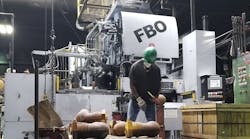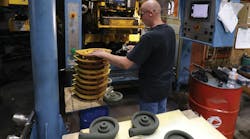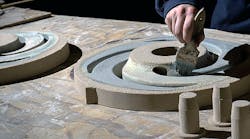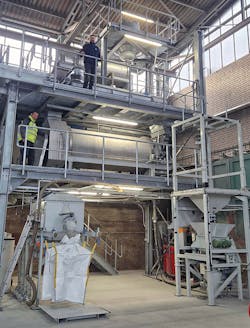The need for energy saving or energy recovery is not new to metalcasting operators but it has taken on some additional relevance over recent months, particularly for European foundries and diecasters. And energy is not the only savings in mind: the molding and core sands containing organic or inorganic binders represent a resource worth recovering too. Last November, FSP Foundry Sand Processing commissioned a pilot plant for a wet-reclamation process for inorganic-bonded sands, and makes it available to foundries for testing their own sands’ suitability for recovery.
“I believe that we will all have to adjust to higher energy prices in the long term,” commented Stefan Zimmermann, managing director of FSP, emphasizing the resource-saving capabilities of the new process. “And we should bear in mind that new sand is not an endless resource.”
FSB reports the process is effective at reclaiming all common “water-glass bonded” (i.e., sodium silicate) foundry sands and special sands from 3D printing processes.
The plant in Stuttgart, Germany, is based on a wet reclamation process patented by DEANTEC GmbH and described as “highly energy-efficient and close to carbon-neutral.” It has a throughput rate of one metric ton per of sand per hour, and FSP claims it will reduce the energy required to dry sand by about 60%. The process removes contaminants from used sands with 98% effectiveness, so the reclaimed material will have nearly equal mechanical strength and flowability as new sand. According to FSP, this means foundries can use it to fulfill up to 95% of their “new” sand requirements.Compared to mechanical sand reclamation processes, the FSP process is gentler to the material. Binders are removed without damaging the grains, and the process is practically dust-free. The fine-grain fraction of the reclaimed sand is less than 0.3% percent, according to FSP, meaning there will be no additional costs for dumping spent sand.
The sand is not dried with heated air; rather, water is converted from liquid to gas using energy recovered from the condensation stage. Dust particles are removed in a patented fluid-bed cooling separator.
Process water is treated and maintained in a closed circuit. One metric ton of sand generates just 12 liters of wastewater, which represents the only freshwater requirement. Because the distillate is fully demineralized, it is better suited to washing the sand than fresh water.
Also, during the distillation process, condensation energy is recovered. Nearly all (95%) of the energy required for evaporation is recovered from condensation.
According to FSP, its patented process also can be used as a wet conditioning method for various types of bulk materials.
As of late 2022 FSP reported it plans to add a thermal treatment stage to the pilot plant in Stuttgart, a process that also will set new energy-efficiency standards, according to the developer.
Typical thermal and combined mechanical-thermal reclamation processes consume 22-30 m³ of gas per metric ton of sand reclaimed, the FSP technology reduces gas consumption to 13-16 m³ of gas/mt. Accordingly, foundries with sand processing rates of about 6 mt/hour may achieve annual gas savings estimated at € 240,000 euros (about $256,000.)
FSP claims to be the first manufacturer of reclamation equipment that also offers contract reclamation services. Under service contracts, the company processes used sand of different origins in its own reclamation facilities, usually located near the customers or in some cases on the foundries’ premises. In either case, FSP GmbH is the operator of the reclamation plant.
“With our process, foundries can save a lot of energy and make their sand reclamation operations almost carbon-neutral because FSP generates the necessary energy itself by cogeneration backed with photovoltaics,” Zimmermann concluded.










